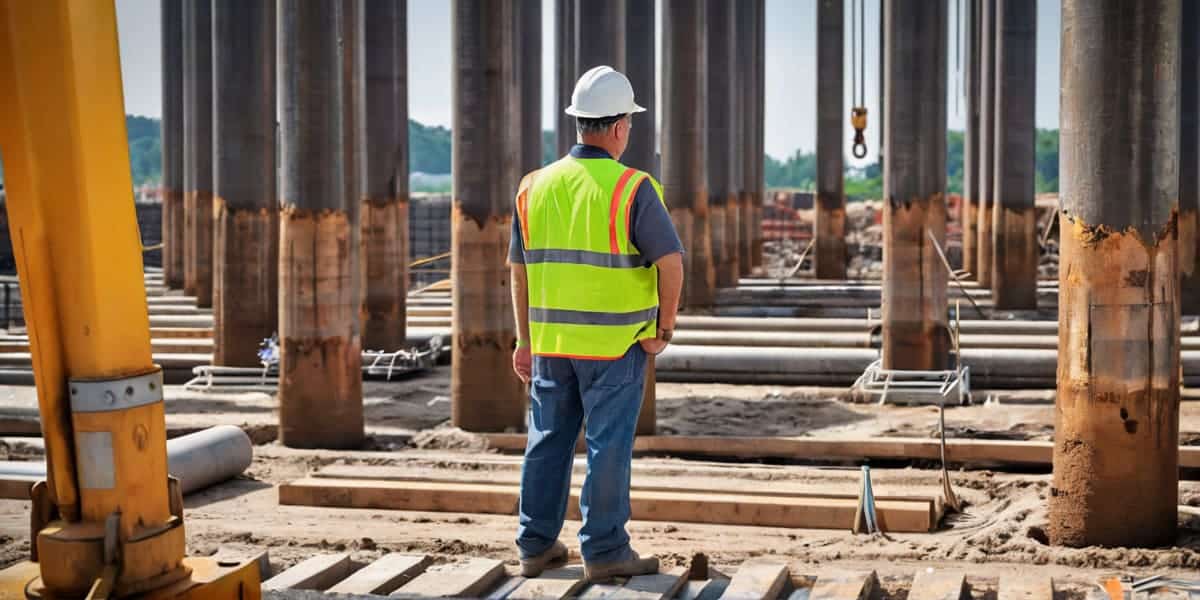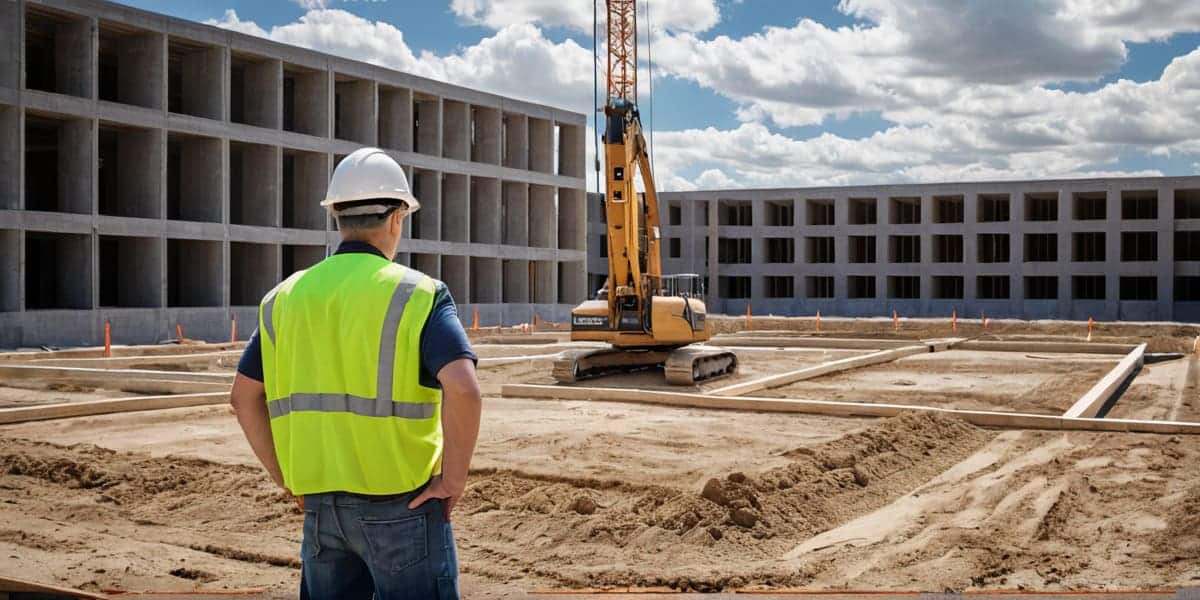 Understanding the Basics of Piling in Foundation Work
Understanding the Basics of Piling in Foundation Work

Fundamental Reasons for Choosing Piling
Piling serves as a robust foundation method, particularly vital in scenarios where soil conditions are not conducive to standard shallow foundations. By delving deep into the ground, piling bypasses weaker soil layers, transferring structural loads to stronger, more stable strata. This is essential for large structures or in areas with challenging geotechnical conditions.
Stability and Longevity Contributions
Piling is synonymous with enhanced stability and longevity for structures. It provides resistance against subsidence and differential settlement, which are critical in maintaining the integrity of a building over time. Especially in areas prone to seismic activity or with high water tables, piling ensures a secure and durable foundation.
Necessity of Piling in Construction Projects
In construction, piling becomes a necessity when the soil’s bearing capacity is insufficient to support conventional foundations, or when there is a need to resist uplift forces in structures such as high-rises or offshore platforms. It is also imperative in urban settings where the underground landscape is congested with utilities and existing foundations.
Initial Investment vs. Long-Term Benefits
While the initial investment in piling may be higher than other foundation methods, the long-term benefits often outweigh the upfront costs. Piling reduces the risk of future structural issues, which can lead to costly repairs and downtime. By investing in a piling foundation, developers ensure the longevity and reliability of their structures, translating into long-term savings and peace of mind.

Decoding Pile Types: A Comparative Analysis
When embarking on a construction project, understanding the nuances of different pile types is crucial for the foundation’s integrity. Piles are categorised based on how they transfer load to the soil, and the choice of pile impacts both the project’s cost and its long-term success.
End-Bearing vs. Friction Piles: Load Distribution
End-bearing piles transfer the weight of the structure directly to a sturdy soil layer or rock, much like a column resting on a solid base. Friction piles, on the other hand, rely on the surface friction along their sides to distribute the load through softer soil layers. The decision between the two often hinges on the depth at which stable soil is found.
Material Choices and Pile Functionality
The materials used for pilestimber, steel, or concreteplay a pivotal role in their performance. Timber is cost-effective but less durable, steel offers high strength and resistance to decay, while concrete provides robustness and longevity. Your choice will depend on factors such as environmental conditions, load requirements, and budget constraints.
Sheet Piles vs. Bored Piles: Application Scenarios
Sheet piles are typically used to create retaining walls for excavation sites or to stabilise slopes. Their interlocking design allows them to form a continuous barrier against water or earth. Bored piles, created by removing soil and filling the void with concrete, are suited for minimising vibrations during construction, making them ideal for urban settings or near sensitive structures.
Driven vs. Cast-in-Place Piles: Advantages and Limitations
Driven piles are pre-formed and hammered into the ground, which is fast and efficient but can cause significant vibrations. Cast-in-place piles, poured on-site, adapt better to varying soil conditions and can be reinforced as needed, but they require more time to cure. The choice often comes down to the project’s timeline, the site’s sensitivity to noise and vibrations, and the soil’s characteristics.

The Piling Process: Step-by-Step Breakdown
Before the first pile is driven into the ground, a meticulous process unfolds to ensure the foundation will stand the test of time. Understanding this process is essential for anyone involved in construction, as it lays the groundwork for a stable and secure structure.
Preliminary Steps in Piling
Prior to installation, a comprehensive site investigation is paramount. This includes:
- Soil Testing: To determine the soil’s bearing capacity and composition.
- Surveying: To map out the site and identify any potential obstructions or underground utilities.
These initial assessments inform the piling strategy and equipment selection, ensuring that the chosen method aligns with the site’s specific conditions.
Pile Installation Execution
The installation of piles is a precise operation, involving specialised equipment such as:
- Pile Drivers: For driving piles into the soil.
- Drilling Rigs: Used in creating bored piles.
- Augers: For excavating soil in preparation for pile placement.
Each piece of equipment plays a role in the seamless execution of the piling process, from the initial ground penetration to the final placement of the pile.
Ensuring Quality During Piling
Quality assurance during piling is non-negotiable. Key considerations include:
- Alignment: Ensuring piles are vertically and horizontally aligned according to design specifications.
- Integrity: Regularly inspecting piles for defects or damage during installation.
Adhering to these quality standards is critical for the integrity of the piling and, by extension, the entire structure.
Building Upon Each Step
Each phase of the piling process builds upon the last, culminating in a foundation that provides enduring support. From the initial soil analysis to the final load testing, every step is interconnected, contributing to the foundation’s overall strength and stability.
Material Matters: Selecting the Right Pile Composition
Selecting the appropriate material for piling is a critical decision that affects the durability, cost, and performance of the foundation. Each material offers distinct advantages and challenges, and the choice must align with the project’s specific requirements.
Comparing Piling Materials
- Timber: Often chosen for its cost-effectiveness and ease of handling, timber is suitable for temporary structures or where conditions prevent corrosion. However, it is less durable than other materials.
- Steel: Known for its high strength and load-bearing capacity, steel is ideal for deep foundations and heavy loads. It is susceptible to corrosion but can be coated for protection.
- Concrete: Offers excellent durability and resistance to fire and pests. Pre-cast concrete piles are quick to instal, while cast-in-situ piles are adaptable to various shapes and sizes.
- Composite Materials: These can include a combination of materials like steel and concrete to leverage the benefits of both. They are often used in specialised applications.
Influencing Factors for Material Selection
The selection of piling materials is influenced by:
- Load Requirements: Higher loads may necessitate stronger materials like steel or reinforced concrete.
- Environmental Conditions: Exposure to elements, water, and soil chemistry can dictate material choice to prevent degradation.
- Project Budget: Cost constraints may lead to the selection of more economical materials that still meet the project’s structural needs.
Trade-Offs in Material Choice
The trade-offs between cost, durability, and performance are pivotal. While timber may be less expensive, its lifespan is shorter compared to steel or concrete. Steel, while strong, may require additional investment in protective coatings. Concrete is robust but may increase the project timeline due to curing times. Your decision should balance these factors to meet the project’s long-term objectives.

Groundwork: Soil Analysis and Site Investigation
Before a single pile is placed, the groundwork for a successful foundation begins with a thorough understanding of the soil’s characteristics. Soil analysis and site investigation are the bedrock of piling, determining the feasibility and guiding the design of the foundation.
The Imperative of Soil Testing
Soil testing is not just a preliminary step; it’s a critical component that influences the entire piling process. By analysing soil samples, you gain insights into:
- Soil Composition: Understanding the types of soil present and their properties.
- Bearing Capacity: Assessing the soil’s ability to support the imposed loads.
- Presence of Water Table: Identifying the level of groundwater which can affect piling choices.
Geotechnical Surveys Shaping Piling Decisions
Geotechnical surveys go beyond mere observation, providing data that informs every aspect of piling design. These surveys help in:
- Identifying Soil Layers: Determining the depth and thickness of different soil strata.
- Choosing Pile Types: Selecting between end-bearing and friction piles based on soil conditions.
Load-Bearing Assessment’s Role
The load-bearing assessment is a pivotal factor in the piling process, ensuring that the piles can support the structure’s weight. It involves:
- Calculating Loads: Determining both the dead and live loads the piles must support.
- Designing for Safety: Ensuring piles have the capacity to handle potential load increases.
Impact of Unexpected Soil Conditions
Unexpected soil conditions can significantly alter the piling strategy. Encountering a different soil type than anticipated may require:
- Re-evaluating Pile Types: Switching to a pile better suited to the new conditions.
- Adjusting Installation Methods: Changing techniques to accommodate soil variability.
By meticulously analysing the soil and site conditions, you lay the groundwork for a foundation that is as robust below ground as the structure it supports above.
Designing for Load-Bearing Efficiency
In the realm of foundation work, the design phase is critical to ensure that the piling can withstand both the static and dynamic forces that the structure will encounter over its lifespan. This section delves into the intricacies of calculating loads and designing pile layouts for optimal efficiency.
Calculating Static and Dynamic Loads
The calculation of loads is a fundamental step in piling design, encompassing:
- Static Loads: These include the weight of the structure itself, along with permanent fixtures.
- Dynamic Loads: Factors such as wind, traffic, and seismic activity contribute to these variable forces.
Engineers use these calculations to determine the size, type, and depth of piles required to support the structure safely.
Principles for Optimal Pile Group Layout
The layout of pile groups is not arbitrary; it follows principles designed to maximise load distribution and minimise potential settlement. Key considerations include:
- Spacing: Ensuring piles are spaced to effectively share the load without compromising structural integrity.
- Arrangement: Configuring piles in a pattern that optimises the interaction between piles and soil.
Influence of Pile Capacity Factors
Pile capacity factors are integral to foundation design, influencing decisions such as:
- Pile Length and Diameter: Tailored to match the load-bearing requirements of the site.
- Material Selection: Chosen based on the capacity needed and environmental conditions.
Emerging Trends in Pile Design
The field of piling is witnessing innovative trends aimed at enhancing load-bearing efficiency, such as:
- Use of High-Strength Materials: To reduce the number of piles needed while maintaining capacity.
- Advanced Modelling Software: For precise simulations of soil-pile interactions under various load scenarios.
By meticulously addressing these aspects, the foundation design not only supports the immediate needs of the structure but also anticipates future demands, ensuring longevity and safety.

Navigating Environmental and Regulatory Landscapes
In the construction industry, piling projects are not just about structural integrity but also about environmental stewardship and regulatory compliance. Understanding these aspects is crucial for any construction company or property developer embarking on foundation work.
Environmental Considerations in Piling
Environmental impact is a significant concern in piling operations. Key considerations include:
- Ecosystem Disruption: Minimising the impact on local flora and fauna during construction.
- Noise and Vibration: Implementing measures to reduce disturbances to surrounding communities.
- Waste Management: Ensuring responsible disposal of any waste materials generated during the piling process.
Regulatory Navigation for Piling Projects
Regulatory requirements are stringent and multifaceted, encompassing:
- Building Codes: Adhering to local and international standards for safe and sustainable construction practices.
- Permitting: Securing all necessary permits before commencing piling operations.
- Inspections: Facilitating regular inspections to ensure ongoing compliance with all regulations.
Best Practices for Minimising Environmental Impact
To minimise the environmental footprint, best practices include:
- Using Sustainable Materials: Opting for materials with a lower environmental impact.
- Advanced Planning: Careful project planning to avoid sensitive areas and reduce resource consumption.
- Innovative Techniques: Employing modern piling methods that are less invasive and more efficient.
Credibility Through Code Adherence
Compliance with building codes not only ensures safety but also enhances the credibility and reputation of the construction firm. It demonstrates a commitment to quality and a respect for the standards that govern the industry. By following these guidelines, companies can ensure that their piling work stands up to scrutiny and contributes to a legacy of excellence in construction.

Overcoming Piling Challenges: Real-World Solutions
Construction companies often encounter a variety of challenges during piling operations. Addressing these effectively is key to maintaining project timelines and ensuring structural integrity.
Innovative Techniques for Soil Heave and Settlement
Soil heave and settlement can compromise the stability of piles. To mitigate these issues, companies may employ:
- Ground Improvement: Techniques such as compaction grouting or soil stabilisation to enhance ground conditions.
- Precise Monitoring: Using instruments to monitor soil movement and adjust the piling strategy accordingly.
Integrating Water Table Management
Managing the water table is critical, especially in areas prone to flooding or with high groundwater levels. Solutions include:
- Dewatering: Temporary reduction of groundwater levels during construction.
- Waterproofing: Applying coatings or barriers to piles to prevent water damage.
Navigating Underground Utilities and Obstructions
Underground utilities and obstructions pose significant risks. To navigate these, construction teams use:
- Utility Mapping: Advanced scanning technology to locate and map utilities before piling begins.
- Obstruction Removal: Careful extraction or rerouting of obstructions to clear the path for piling.
By proactively addressing these challenges with innovative solutions and careful planning, construction companies can ensure the successful completion of piling projects, laying a solid foundation for the structures they support.
Ensuring Pile Integrity: Quality Control Measures
Quality control in piling is paramount to the longevity and safety of a structure. It involves a series of checks and tests to ensure that each pile meets the required standards and will perform as expected over the structure’s lifetime.
Non-Destructive Testing for Pile Integrity
To assess the integrity of piles without causing damage, several non-destructive testing methods are employed:
- Ultrasonic Testing: Uses sound waves to detect internal flaws or inconsistencies.
- Radiographic Testing: Employs X-rays or gamma rays to visualise the internal structure of the piles.
- Magnetic Particle Inspection: Reveals surface cracks by detecting magnetic field disruptions.
These methods allow for early detection of potential issues, ensuring that any deficiencies are addressed promptly.
Monitoring Pile Performance
Ongoing monitoring of pile performance is crucial for maintaining structural integrity. This includes:
- Load Testing: Applying weight to the pile to ensure it can support the expected loads.
- Instrumentation: Embedding sensors to track movement, tilt, and strain over time.
Adhering to Industry Standards
The piling industry adheres to stringent standards, which include:
- ASTM and ISO Guidelines: Providing protocols for materials, testing, and installation.
- Local Building Codes: Ensuring compliance with regional safety and quality requirements.
Continuous Improvement in Testing
The piling sector is committed to continuous improvement, with advancements in testing contributing to:
- Enhanced Safety: Reducing the risk of foundation failure.
- Increased Efficiency: Streamlining the testing process to save time and resources.
By rigorously applying these quality control measures, the piling industry upholds the highest standards of safety and performance, ensuring that each foundation is built to last.

The Economic Perspective: Cost-Benefit Analysis of Piling
Evaluating the cost-effectiveness of piling is a multifaceted process that construction companies undertake to ensure financial prudence while achieving structural integrity. The economic analysis of piling involves a thorough examination of both immediate costs and long-term value.
Evaluating Piling Cost-Effectiveness
Construction companies assess the cost-effectiveness of piling by considering:
- Initial Investment: The upfront cost of materials, equipment, and labour.
- Longevity: The expected lifespan of the piling and potential savings from reduced maintenance.
- Risk Mitigation: The cost savings associated with preventing future structural issues.
Long-Term Economic Benefits of Piling
Investing in robust piling can yield significant long-term economic benefits, such as:
- Durability: A strong foundation reduces the need for costly repairs and extends the life of the structure.
- Property Value: Structures with solid foundations can command higher market values.
Piling’s Contribution to Project Budget and Timeline
Piling can influence the overall project budget and timeline through:
- Efficiency: Selecting the right piling method can streamline construction and reduce delays.
- Resource Allocation: Effective piling may allow for resource reallocation to other project areas.
Financial Considerations in Piling Choices
The choice of piling methods and materials is influenced by financial considerations, including:
- Cost of Materials: Balancing the quality of materials with budget constraints.
- Labour and Equipment: The expense of specialised labour and machinery for installation.
By carefully analysing these economic factors, companies can make informed decisions that balance cost with quality, ensuring the financial viability of their construction projects.

Technological Advancements: The Future of Piling
The piling industry is undergoing a significant transformation, driven by technological advancements that promise to enhance efficiency and precision in foundation work.
Innovations Shaping Piling’s Future
Recent technological innovations are revolutionising the way piling is conducted:
- Hydraulic Hammers: These provide more power and control, allowing for quicker and more efficient pile driving.
- Vibratory Drivers: They reduce noise and increase speed, particularly beneficial in urban areas.
- Numerical Analysis: Advanced software for simulating piling under various conditions, leading to more accurate designs.
Digital Tools and Software Enhancements
Digital tools and software are integral to modern piling, improving aspects such as:
- Design Precision: 3D modelling software enables precise visualisation of pile placement and load distribution.
- Efficiency: Project management tools streamline the planning and execution of piling operations.
Automation’s Role in Piling
Automation is playing an increasingly important role in piling by:
- Enhancing Safety: Automated machinery reduces the need for manual labour in hazardous conditions.
- Increasing Consistency: Robots and automated systems ensure that piles are driven with consistent force and direction.
Adapting to New Materials and Methods
The industry is rapidly adapting to new materials and methods, such as:
- Composite Materials: These offer strength and durability without the weight of traditional materials.
- Eco-Friendly Techniques: Sustainable practices are being developed to minimise the environmental impact of piling.
By embracing these advancements, the piling industry is not only improving current practices but also paving the way for future innovations that will continue to shape the landscape of construction.

Building on Solid Ground: The Keystone of Construction
A comprehensive grasp of piling principles is not just beneficialit’s a cornerstone of successful construction. For property developers and construction companies, understanding the intricacies of piling is akin to mastering the art of building a strong foundation, both literally and figuratively.
Key Takeaways for Property Developers
For those in the realm of property development, piling represents more than just a technical process; it’s a strategic investment in the longevity and reliability of a structure. Key takeaways include:
- Risk Mitigation: Recognising that proper piling can significantly reduce future structural risks.
- Value Addition: Understanding that a well-executed piling process can enhance the value of a property.
Theory Meets Practice in Piling
The integration of theoretical knowledge with practical application in piling ensures that:
- Best Practices: Are consistently applied, leading to safer, more efficient construction.
- Innovation: Continues to drive the industry forward, with new materials and methods being developed.
Anticipating the Future of Piling
Looking ahead, the field of piling and foundation work is poised for exciting developments:
- Sustainable Practices: A growing focus on environmentally friendly piling techniques.
- Technological Advancements: The adoption of AI and machine learning for predictive analysis and design optimization.
By staying informed and adaptable, the construction industry can continue to build on solid ground, ensuring that each new project stands as a testament to the enduring power of a strong foundation.



